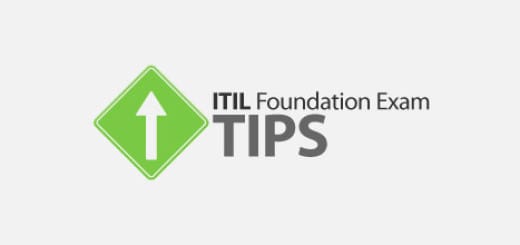ITIL v3 Foundation Certification Notes: Service Design [2]

[ITIL® v3 Foundation Notes] An important process of the Service Design phase for the ITIL® 4 Foundation Certification exam is covered here: service level management (SLM). The purpose, objectives, and scope of the processes and their importance in the Service Design lifecycle stage are addressed.
Article Highlights
Service Level Management Process
- Purpose of SLM: ensure that all current and planned IT services are delivered to agreed achievable targets (service level agreement) using an objective measurement through discussion and negotiation with customers
- primarily concerned about the warranty aspects (security, capability, availability, service continuity), if accurately captured, will translate into “quality” of the service
- Objectives of SLM
- define, document, agree, monitor, measure, report, and review how well the IT service is delivered
- ensure specific and measurable targets are developed
- work with business relationship management to build a working relationship with the customers
- ensure customers have a clear and unambiguous expectation of the service level
- ascertain customer satisfaction through surveys, interviews, etc. with an agreed satisfaction score
- improve services through a cost-effective and proactive way
- Scope of SLM
- includes the performance of existing services and the definition of required service levels for planned services (service level requirements) for expectation management
- agreed in the form of service level agreement (SLA) for warranty
- when 3rd parties are involved, operation-level agreements (OLA – for internal units) and underpinning contracts (external) are also required
- NOT including utility
- review with customer for the service quality (better with face-to-face meetings), SLA might be re-negotiated depending on the circumstances
- Activities involved:
- Designing SLA frameworks
Using the Service Catalog as an aid, SLM must design the most appropriate SLA structure to ensure that all services and all customers are covered in a manner best suited to the organization’s needs, e.g. multi-level SLA, etc. - Determine, negotiate, document and agree requirements for new or changed services in SLRs, and manage and review them through the service lifecycle into SLAs for operational services.
Once the Service Catalog has been produced and the SLA structure has been agreed, a first SLR must be drafted. It is advisable to involve customers from the outset, and to produce a first outline draft of the performance targets and the management and operational requirements, as a starting point for more detailed and in-depth discussion. - Monitor and measure service performance achievements of all operational services against targets within SLAs.
- Measure and improve customer satisfaction.
There are a number of important ‘soft’ issues that cannot be monitored by mechanistic or procedural means, such as customers’ overall feelings. For example, even when there have been a number of reported service failures, the customers may still feel positive about things, because they may feel satisfied that appropriate actions are being taken to improve things. - Review and revise underpinning agreements and service scope.
IT service providers are dependent to some extent on their own internal technical support teams or on external partners or suppliers. They cannot commit to meeting SLA targets unless their own support team’s and suppliers’ performances underpin these targets. - Produce service reports.
As soon as the SLA is agreed and accepted, monitoring must be instigated and service achievement/misses reports must be produced. The SLA reporting mechanisms, intervals and report formats must be defined and agreed with the customers. Exception reports are needed whenever there are incidents. - Conduct service reviews and instigate improvements within an overall Service Improvement Program/Plan (SIP).
Periodic review meetings must be held on a regular basis with customers (or their representatives) to review the service achievement in the last period and to preview any issues for the coming period. It is normal to hold such meetings monthly, or as a minimum, quarterly. - Review and revise SLAs, service scope and underpinning agreements.
All agreements and underpinning agreements, including SLAs, underpinning contracts and OLAs, must be kept up-to-date. They should be brought under Change and Configuration Management control and reviewed periodically, at least annually, to ensure that they are still current and comprehensive, and are still aligned to business needs and strategy. - Develop and document contacts and relationships with the business, customers and stakeholders.
It is very important that SLM develops trust and respect with the business, especially with the key business contacts. Using the Service Catalog, especially the Business Service Catalog element of it, enables SLM to be much more proactive. - Develop, maintain and operate procedures for logging, action and resolving all complaints, and for logging and distributing compliments.
The logging procedures are often performed by the Service Desk as they are similar to those of Incident Management and Request Fulfillment.
- Designing SLA frameworks
- includes the performance of existing services and the definition of required service levels for planned services (service level requirements) for expectation management
- Output of SLM: Service Level Agreement (SLA)
- Mutli-level SLAs – Service Level SLA (may include multiple classes e.g. gold, silver, bronze), Customer Level SLA, Corporate Level SLA
- Periodic review of the SLA is required
- Red (target breached), amber (target threatened), green (target reached) are commonly used in service level management monitoring charts (SLAM charts)
- In case of identifying issues, service improvement plan (SIP) would need to be drafted and agreed upon for further actions. The SLM would work with the CSI manager on the issue.
- Whether an SIP is required depends on the cost of improvement actions and the business benefit
- Interface with Other Processes
- Business relationship management
- This process ensures that the service provider has a full understanding of the needs and priorities of the business and that customers are appropriately involved/represented in the work of service level management.
- Service catalogue management
- This process provides accurate information about services and their interfaces and dependencies to support determining the SLA framework, identifying customers/business units that need to be engaged by SLM and to assist SLM in communicating with customers regarding services provided.
- Incident management
- This process provides critical data to SLM to demonstrate performance against many SLA targets, as well as operating with the fulfillment of SLA targets as a CSF. SLM negotiates support-related targets such as target restoration times and then the fulfillment of those targets is embedded into the operation of the incident management process.
- Supplier management
- This process works collaboratively with SLM to define, negotiate, document and agree terms of service with suppliers to support the achievement of commitments made by the service provider in SLAs. Supplier management also manages the performance of suppliers and contracts against these terms of service to ensure related SLA targets are met.
- Availability, capacity, IT service continuity and information security management
- These processes contribute to SLM by helping to define service level targets that relate to their area of responsibility and to validate that the targets are realistic. Once targets are agreed, the day-to-day operation of each process ensures achievements match targets.
- Financial management for IT services
- This process works with SLM to validate the predicted cost of delivering the service levels required by the customer to inform their decision-making process and to ensure that actual costs are compared with predicted costs as part of the overall management of the cost effectiveness of the service.
- Design coordination
- During the service design stage, this process is responsible for ensuring that the overall service design activities are completed successfully. SLM plays a critical role in this through the development of agreed SLRs and the associated service targets which the new or changed service must be designed to achieve.
- Business relationship management
Key Concepts and Terms
Service Level Requirements (SLR)
- represents what is required by the customer in an objective way for a particular aspect of the service based on business objectives (e.g. checkout capability increase by 20% over the existing system)
- high level SLRs are formulated during Service Strategy to consider the value of the service while details SLRs are developed during Service Design
- need to be agreed with by both customer and IT development team
- form an important part of the service design specifications
- testing criteria need to be developed for testing
Service Level Agreement (SLA)
- Based on the work done with SLR, SLA describes the service and the quality measures by which the delivery of that service will be judged (in plain terms to avoid confusion), telling what is and is not provided
- signed by the provider and the customer and monitored by both through reporting (with enough details)
- trending in the service level must also be monitored to ensure quality
- Contents of SLA:
- description of the purpose and scope of the document (location, date, what’s included and not)
- support service and period
- level of availability, reliability, service continuity and security and the measurement metrics (to reflect the level of service experienced by the customer)
- If the service support involves other internal units or external parties, operation-level agreements and underpinning contracts are also required before signing of the SLA
- Operation-level Agreements (OLAs) – straightforward agreement to specify the realistic level of support to another internal unit, legal jargons are not needed
- Underpinning Contracts (UCs) – contractual and therefore legally enforceable agreements, sufficient monitoring and reporting are needed
- Structure of SLA:
- Service-based – each SLA refers to only one service (organization-wide service)
- Customer-based – an SLA for a customer
- Multilevel – include corporate, customer and service levels
Conclusion: ITIL® v3 Foundation Service Design
This ITIL® v3 Foundation study note provides a discussion on the purpose, objectives and scope of service level management process. The various types of documents including service level requirements (SLR), service level agreements (SLA), operational-level agreement (OLA) and underpinning contract (UC) are also explained.
After an in-depth discussion of the Service Level Management, the next part of Service Design study notes will cover service catalog management, availability management, information security management, supplier management, capacity management, IT service continuity management and design coordination





 Hi, my name is Edward Chung, PMP, PMI-ACP®, ITIL® Foundation. Like most of us, I am a working professional pursuing career advancements through Certifications. As I am having a full-time job and a family with 3 kids, I need to pursue professional certifications in the most effective way (i.e. with the least amount of time). I share my exam tips here in the hope of helping fellow Certification aspirants!
Hi, my name is Edward Chung, PMP, PMI-ACP®, ITIL® Foundation. Like most of us, I am a working professional pursuing career advancements through Certifications. As I am having a full-time job and a family with 3 kids, I need to pursue professional certifications in the most effective way (i.e. with the least amount of time). I share my exam tips here in the hope of helping fellow Certification aspirants!





